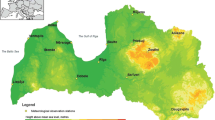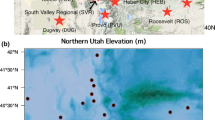Abstract
This study analyzed the spatial and temporal distributions of various fog types over South Korea. Six types of fogs were identified using a classification algorithm based on simple conceptual models of fog formation. The algorithm was applied to a 25-year record of meteorological observations. The most common fog types were radiation fog, prevailing at inland stations, and precipitation fog at coastal and island stations. Declining temporal trends in the frequency of fog events ranging between 2.1 and 10.9 fog events per decade were found at eight inland and two coastal stations. Long-term trends for each fog type show that the decrease in the frequency of fog events is mainly due to a decrease in the frequency of radiation fogs ranging between 1.1 and 8.5 fog events per decade. To identify the potential factors related to the decrease in radiation fog events, the temporal trends in annual mean nocturnal maximal cooling rates and annual mean nocturnal specific humidity during nights with clear sky and clam winds were examined. The results show that the decrease in the frequency of radiation fog events is associated mainly with the pattern of urbanization occurring during the past two decades.







Similar content being viewed by others
References
Baars, JA, Witiw M, Al-Habash A (2003) Determining fog type in the Los Angeles basin using historic surface observation data. Proc. 16th Conf. on Probability and Statistics in the Atmospheric Sciences, Long Beach, CA, Amer Meteor Soc, CD-ROM, J3.8
Baker R, Cramer J, Peters J (2002) Radiation fog: UPS Airlines conceptual models and forecast methods. Proc. 10th Conf. on Aviation, Range and Aerospace Meteorology, Portland, OR, Amer Meteor Soc 154–159
Byers HR (1959) General meteorology, 4th edn. McGraw-Hill, New York, pp 277–279
Cho YK, Kim MO, Kim BC (2000) Sea fog around the Korean Peninsula. J Appl Meteorol 39:2473–2479
Chow SD (1992) The urban climate of Shanghai. Atmos Environ 26B:9–15
Chow WTL, Svoma BM (2011) Analyses of nocturnal temperature cooling-rate response to historical local-scale urban land-use/land cover change. J Appl Meteorol Climatol 50:1872–1883
Forthun GM, Johnson MB, Schmitz WG, Blume J, Caldwell RJ (2006) Trends in fog frequency and duration in the southeast United States. Phys Geogr 27:206–222
George JJ (1951) Fog. Compendium of meteorology. In: Malone TF (ed) Amer Meteor Soc, 1179–1189
Gultepe I, Milbrandt JA (2010) Probabilistic parameterizations of visibility using observations of rain precipitation rate, relative humidity, and visibility. J Appl Meteorol Climatol 49:36–46
Johnstone JA, Dawson TE (2010) Climatic context and ecological implications of summer fog decline in the coast redwood region. Proc Natl Acad Sci 107:4533–4538. doi:10.1073/pnas.0915062107
Kim YH, Baik JJ (2004) Daily maximum urban heat island intensity in large cities of Korea. Theor Appl Climatol 79:151–164. doi:10.1007/s00704-004-0070-7
Lee CB (1981) Changes of fog days and cloud amount by artificial lakes in Chuncheon. J Korean Meteorol Soc 17:18–26
Niu F, Li Z, Li C, Lee KH, Wang M (2010) Increase of wintertime fog in China: potential impacts of weakening of the Eastern Asian monsoon circulation and increasing aerosol loading. J Geophys Res 115:D00K20. doi:10.1029/2009JD013484
Petterssen S (1939) Some aspects of formation and dissipation of fog. Geofys Publ 12:5–22
Petterssen S (1969) Introduction to meteorology, 3rd edn. McGraw-Hill, New York, p 505
Ryznar E (1977) Advection-radiation fog near Lake Michigan. Atmos Environ 11:427–430
Sachweh M, Koepke P (1995) Radiation fog and urban climate. Geophys Res Lett 22:1073–1076
Sugimoto S, Tomonori S, Kazuki N (2013) Effects of synoptic-scale control on long-term declining trends of summer fog frequency over the Pacific side of Hokkaido Island. J Appl Meteorol Climatol 52:2226–2242
Syed FS, Körnich H, Tjernström M (2012) On the fog variability over south Asia. Clim Dyn 39:2993–3005
Tardif R, Rasmussen RM (2007) Event-based climatology and typology of fog in the New York City region. J Appl Meteorol Climatol 46:1141–1168
Tardif R, Rasmussen RM (2008) Process-oriented analysis of environmental conditions associated with precipitation fog events in the New York City region. J Appl Meteorol Climatol 47:1681–1703
van Oldenborgh GJ, Yiou P, Vautard R (2010) On the roles of circulation and aerosols in the decline of mist and dense fog in Europe over the last 30 years. Atmos Chem Phys 10:4597–4609
Vautard R, Yiou P, van Oldenborgh GJ (2009) Decline of fog, mist and haze in Europe over the past 30 years. Nat Geosci 2:115–119
Willet HC (1928) Fog and haze, their cases, distribution, and forecasting. Mon Weather Rev 56:435–468
Acknowledgments
The authors wish to thank Robert Tardif at the Department of Atmospheric Science, University of Washington and Jeffrey Scott Owen at the Department of Environmental Science, Hankuk University of Foreign Studies for their suggestions and comments.
Author information
Authors and Affiliations
Corresponding author
Rights and permissions
About this article
Cite this article
Belorid, M., Lee, C.B., Kim, JC. et al. Distribution and long-term trends in various fog types over South Korea. Theor Appl Climatol 122, 699–710 (2015). https://doi.org/10.1007/s00704-014-1321-x
Received:
Accepted:
Published:
Issue Date:
DOI: https://doi.org/10.1007/s00704-014-1321-x




